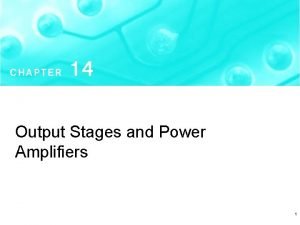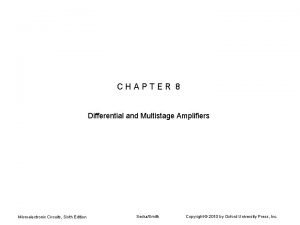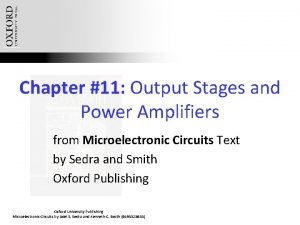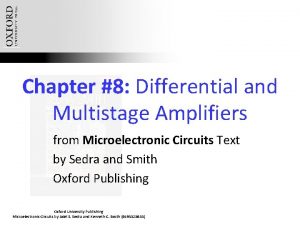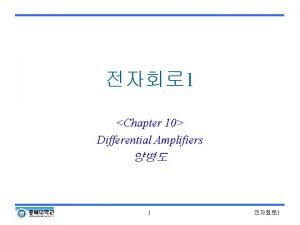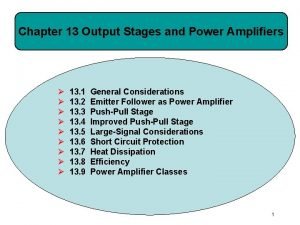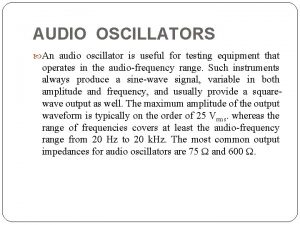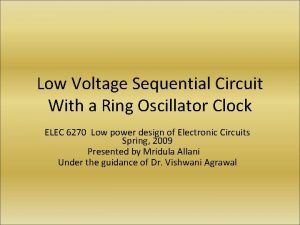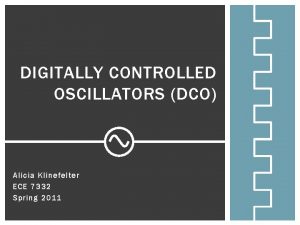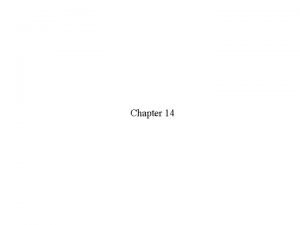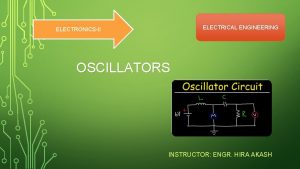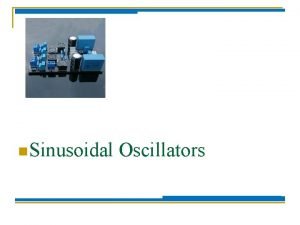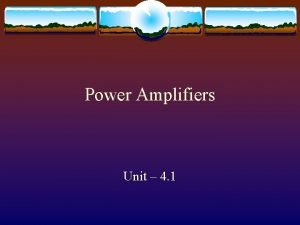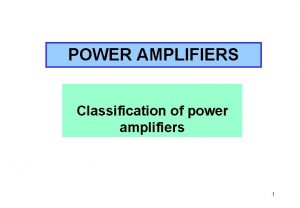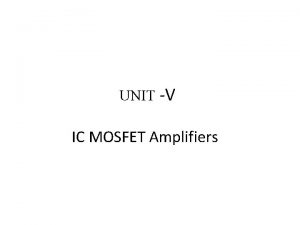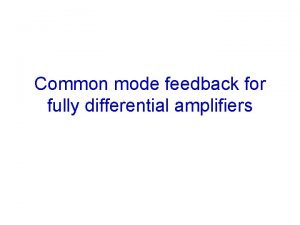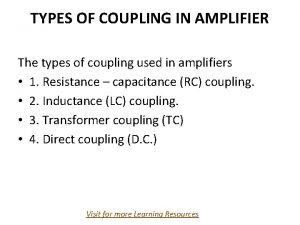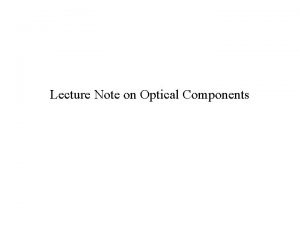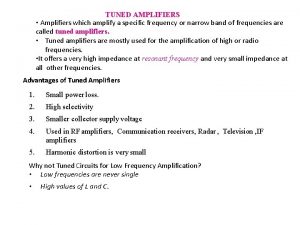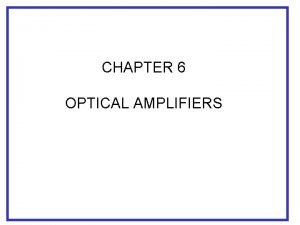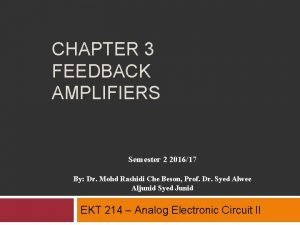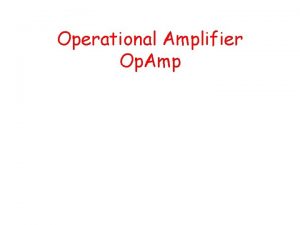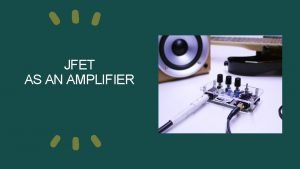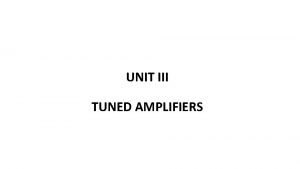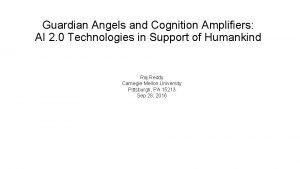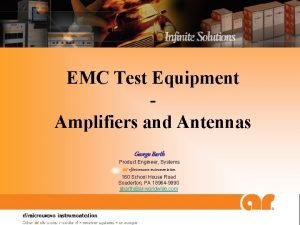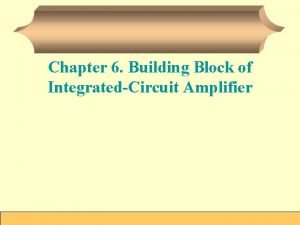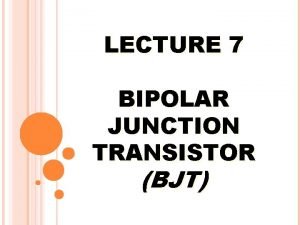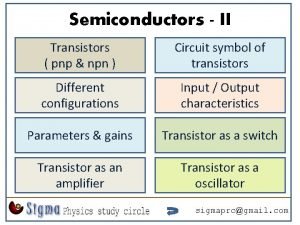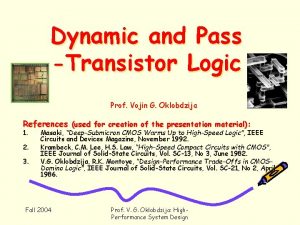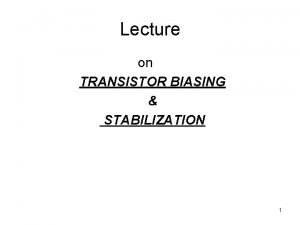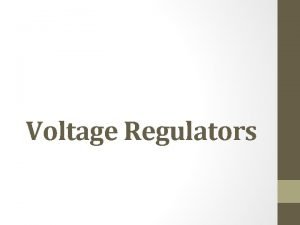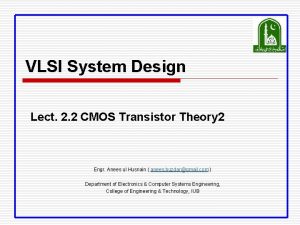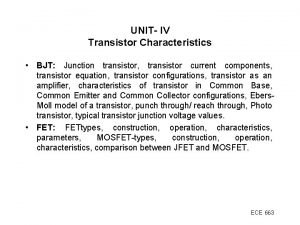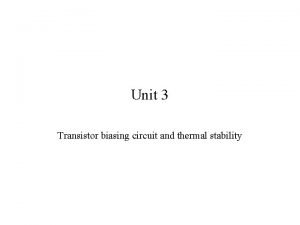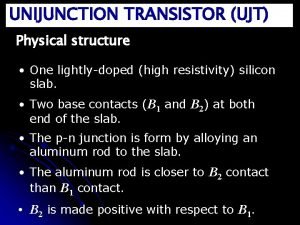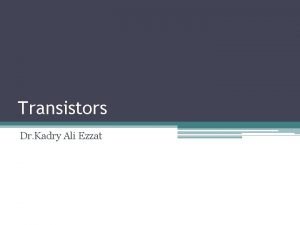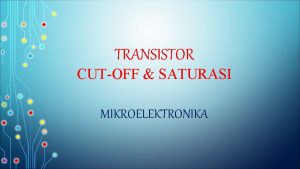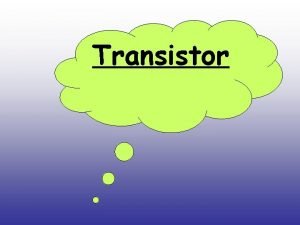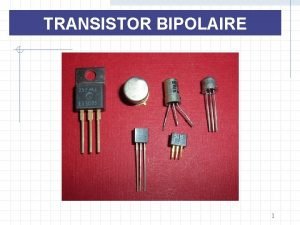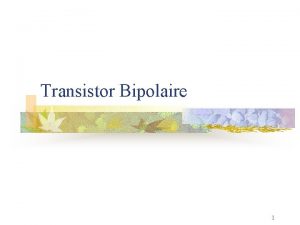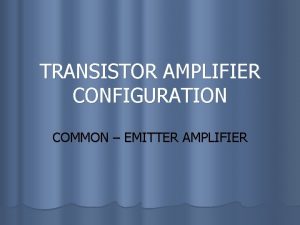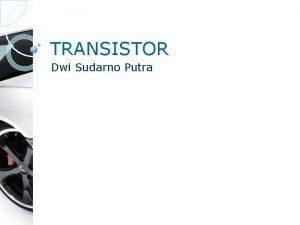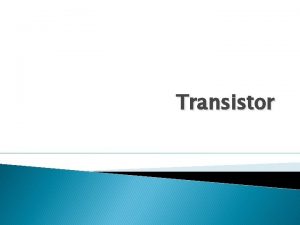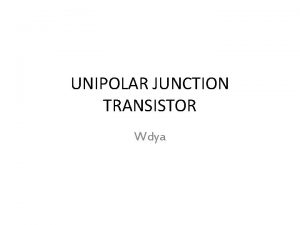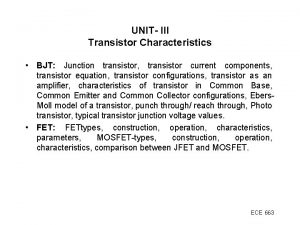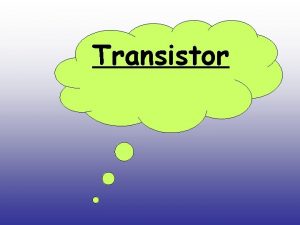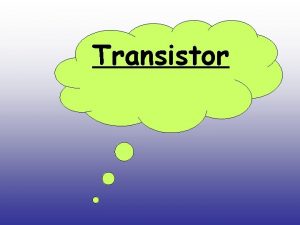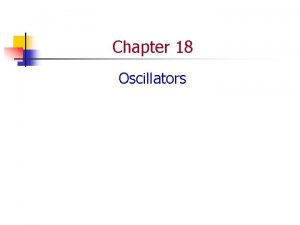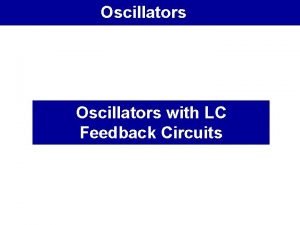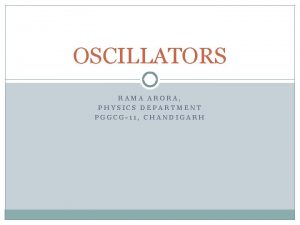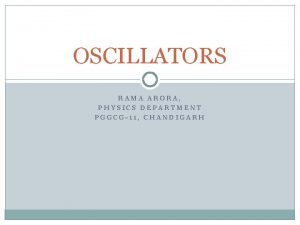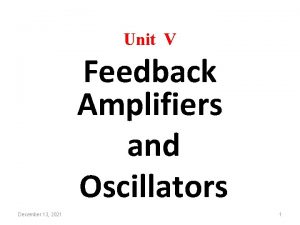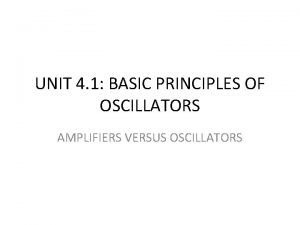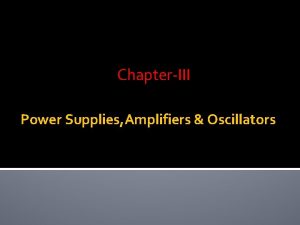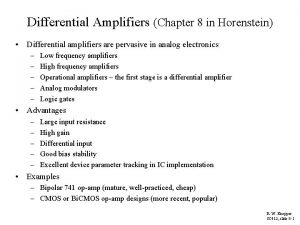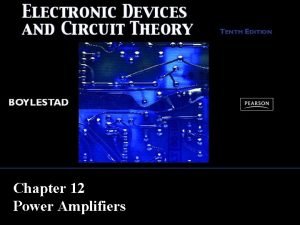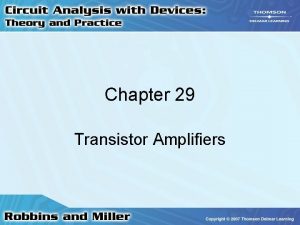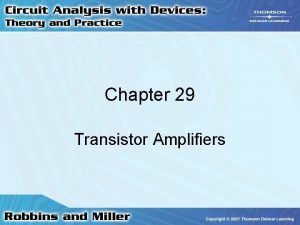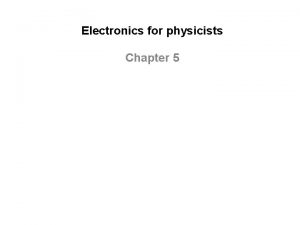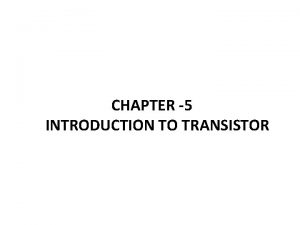CHAPTER 19 AMPLIFIERS AND OSCILLATORS 1 Transistor AC














































- Slides: 46

CHAPTER 19 AMPLIFIERS AND OSCILLATORS 1

Transistor AC equivalent circuits l l 2 h (hybrid) parameters r parameters

Relation of transistor symbol to rparameter equivalent 3

The AC bata and Remember that and l 4

COMMON-EMITTER AMPLIFIERS 5

DC equivalent circuit for CE 6 DC equivalent (C-open circuit) AC equivalent (C-short circuit)

r-parameter model 7

A Bypass Capacitor Increases Voltage Gain 8

Phase Inversion and AC input resistance 9

Phase Inversion and AC input resistance l l 10 The CE amplifier, the output voltage at the collector is 180°out of phase with the input voltage at the base The dc input resistance (RIN) can be defined as:

Phase Inversion and AC input resistance l l 11 The CE amplifier, the output voltage at the collector is 180°out of phase with the input voltage at the base The dc input resistance (RIN) can be defined as:

Current and Power gain for CE l Current gain is the source current is calculated by l 12 Power gain

COMMON-COLLECTOR AMPLIFIERS (EMITTER-FOLLOWER) 13

Voltage gain and Input resistance for CC 14

Current and Power gain for CC l Current gain is the source current is calculated by l 15 Power gain

The Darlington Pair 16

COMMON-BASE AMPLIFIERS 17

Voltage and Current gain for CB Voltage gain 18 Current gain

Power gain and Input Resistance Power gain 19 Input resistance

FET Amplifiers l Transconductance of a FET – – 20 The transconductance is one factor that determines the voltage gain of a FET amplifier Sometime called the forward transconductance and is designated with units of Siemens (S(

Common-Source (CS) Amplifiers 21

Voltage gain and Input Resistance for CS 22

Common-Drain (CD) or Source-follower Amplifiers 23

Common-Gate (CG) Amplifiers 24

Voltage gain and Input Resistance Voltage gain 25 Input resistance

MULTISTAGE AMPLIFIERS 26 l Multistage gain l Decibel Voltage Gain

Multistage Analysis 27

Multistage Analysis (continue) l 28 The voltage gain of the first stage is reduced by the loading of the second stage

CLASS OPERATION l l 29 CLASS A OPERATION CLASS B OPERATION CLASS AB OPERATION CLASS C OPERATION

CLASS A OPERATION 30

CLASS A OPERATION) continue( l 31 A noncentered Q-point Limits Output Swing

CLASS B PUSH-PULL AMPLIFIER OPERATION 32

CLASS B PUSH-PULL AMPLIFIER OPERATION) continue( 33

CLASS B PUSH-PULL AMPLIFIER OPERATION) continue( 34

CLASS AB OPERATION 35

CLASS AB OPERATION (continue) 36

CLASS C OPERATION l 37 Class C amplifiers are biased so that conduction occurs for much less than 180°, and are more efficient than either class A or class B

OSCILLATORS l l Oscillator Principles An oscillator converts electrical energy in the form of DC to electrical energy in the form of AC Condition for oscillation – – 38 The phase shift around the feedback loop must be 0° The loop gain must be least 1 (unity gain)

Oscillator Principles (positive feedback) 39

Start-up conditions 40

The RC Oscillator 41

The Colpitts Oscillator 42

The Hartley Oscillator 43

The Clapp Oscillator 44

The crystal oscillator 45

The crystal oscillator (continue) 46
 Vbe multiplier circuit
Vbe multiplier circuit Differential and multistage amplifiers
Differential and multistage amplifiers Classification of output stages
Classification of output stages Differential and multistage amplifiers
Differential and multistage amplifiers Differential and multistage amplifiers
Differential and multistage amplifiers Output stages and power amplifiers
Output stages and power amplifiers Audio oscillator
Audio oscillator Low g oscillators 50low
Low g oscillators 50low Digitally controlled oscillators
Digitally controlled oscillators The figure shows four oscillators at t=0
The figure shows four oscillators at t=0 Classification of oscillators
Classification of oscillators Sinusoidal oscillators are
Sinusoidal oscillators are Classification of power amplifiers
Classification of power amplifiers Classification of power amplifiers
Classification of power amplifiers A cs amplifier utilizes a mosfet with
A cs amplifier utilizes a mosfet with Op amp isolation circuit
Op amp isolation circuit Common mode feedback
Common mode feedback Two stage transformer coupled amplifier
Two stage transformer coupled amplifier Optical amplifiers lecture notes
Optical amplifiers lecture notes In tuned amplifiers harmonic distortion is
In tuned amplifiers harmonic distortion is In-line optical dwdm amplifiers
In-line optical dwdm amplifiers Classify feedback amplifiers
Classify feedback amplifiers Applications of amplifiers
Applications of amplifiers Operational amplifier is also called as
Operational amplifier is also called as Ac drain resistance
Ac drain resistance Series series feedback amplifier
Series series feedback amplifier Transistor
Transistor Angels in amplifiers
Angels in amplifiers Twt amplifiers for emc testing
Twt amplifiers for emc testing Building blocks of integrated-circuit amplifiers
Building blocks of integrated-circuit amplifiers Difference between npn and pnp
Difference between npn and pnp Condition for thermal stability in transistor
Condition for thermal stability in transistor Gmail
Gmail Difference between pass transistor and transmission gate
Difference between pass transistor and transmission gate Ic=beta ib+
Ic=beta ib+ Emitter follower voltage regulator
Emitter follower voltage regulator Vlsi transistor
Vlsi transistor Unit of transistor
Unit of transistor Thermal stability in bjt
Thermal stability in bjt Ujt transistors
Ujt transistors Bipolar transistor configurations
Bipolar transistor configurations Npn transistor doping
Npn transistor doping Transistor saturation
Transistor saturation P type bjt
P type bjt Montage transistor en commutation
Montage transistor en commutation Schema equivalent transistor
Schema equivalent transistor Ac load line analysis of transistor
Ac load line analysis of transistor
